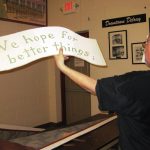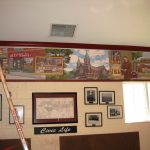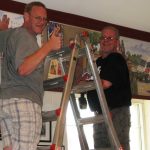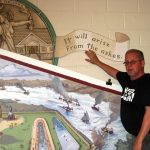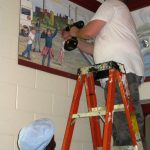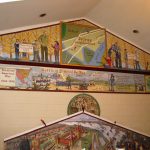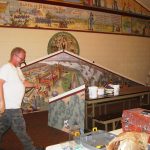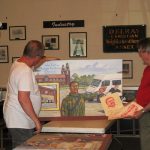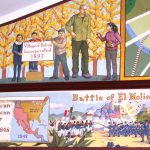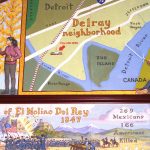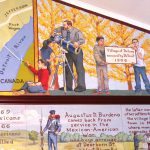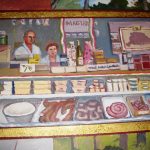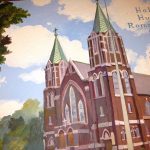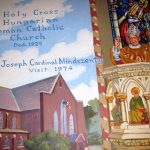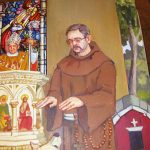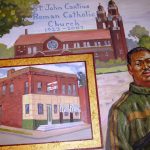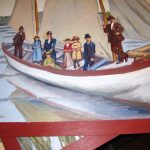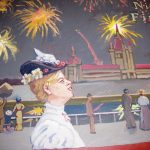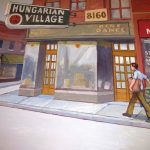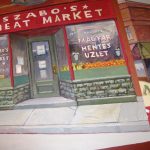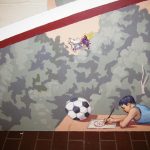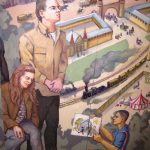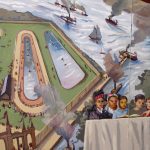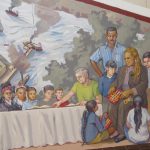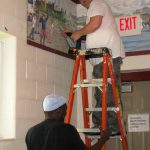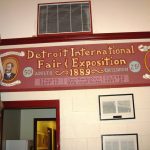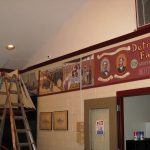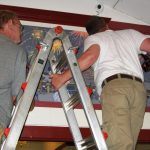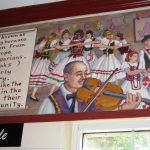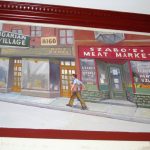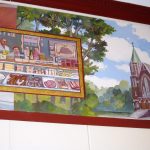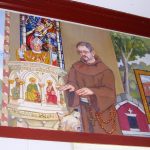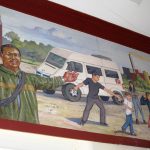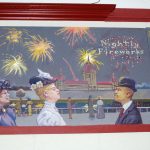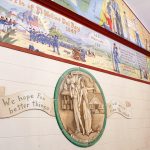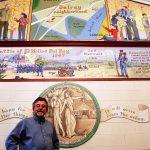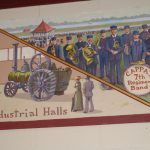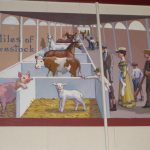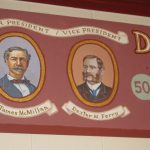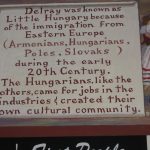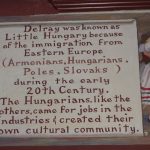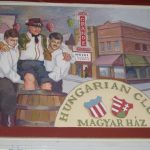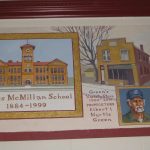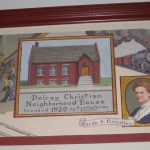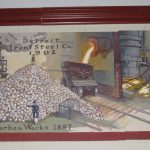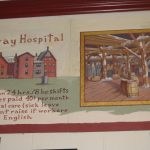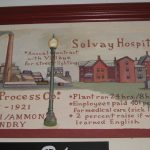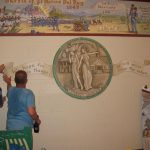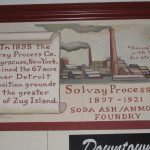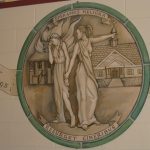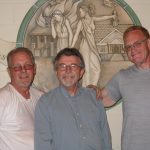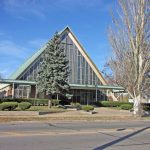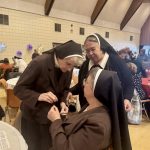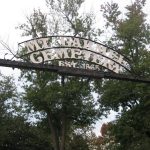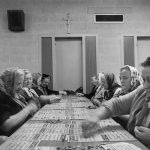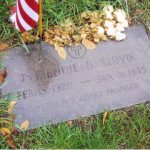“It Will Rise from the Ashes”: Hamtramck Muralist Dennis Orlowski Breathes New Life into Old Delray
There are no white picket fences in front of the houses on S. Leigh Street in old Delray leading into the Delray Community Center. Approaching the neighborhood from Dearborn Street, the area, like so many neighborhoods in scattered pockets of Detroit, is an urban desert reminiscent of old Southern ghost towns. At an intersection around S. Cobalt and Melville Streets you could swear that in a heartbeat you were transported from I-75 back into the Depression era and the fictional town of Whistle Stop, Alabama, as depicted in the last scene of the movie Fried Green Tomatoes. What once existed of the gas station and the little store on the two opposite corners of the intersection has been scattered to the winds of time along with the stories of the generations of people who once filled the town with life.
And perhaps it’s not so far-fetched that one should feel the spirits of yesterday whispering from the dusty roadside in the rustle of the Queen Anne’s lace, or dancing in the blue cornflower. Delray, situated on the banks of the Rouge River, is home to what was one of the largest Native American mounds used for the interment of their dead. The mound, which was 40 feet high and several hundred feet long, is believed to have been used by successive tribes. Evidence also suggests that it was used by successive generations of Native Americans, and the stories swirl around in Delray today of ghosts that inhabit these parts, perhaps due to disturbance of the mound. And that’s just the beginning of the story that Hamtramck muralist Dennis Orlowski tells in his latest mural.
No stranger to Hamtramck, Dennis Orlowski has 50-some murals scattered across the metro Detroit area, and more worldwide. His 168-foot “History of Hamtramck” in the Mayson Center on Jos. Campau, completed in 2003, took three years to finish. How he came to paint the history of Delray in the Delray Community Center at 420 S. Leigh Street was through Tom Cervenak, the Center’s Executive Director until his recent retirement. Tom approached Dennis at one of Dennis’ exhibits in Hamtramck in early 2015 and asked him if he would create something historical for Delray in the Community Center’s community room before Tom retired. Of course, Dennis was interested.
In January 2015, the West Side Detroit Polish American Historical Society had commissioned Dennis to paint a mural depicting life in historic west side Polonia’s neighborhoods for its Heritage Room in St. Colette in Livonia. Thus, Dennis worked simultaneously on both murals.
The community room of the Delray Community Center presented some unique challenges. The mural was to be painted on the two opposite gabled walls, at ceiling level. The highest point of the walls is approximately 25 feet from ground level. Although Tom had commissioned Dennis to paint only the two gabled areas, in order to fully capture Delray’s history Dennis suggested that he also paint a bordering panel underneath the gabled areas, which would extend around all four walls to completely encircle the room.
The story of the Delray Community Center mural is many stories within a story. It’s a story of the past giving way to the present, the present giving birth to a new generation, and that generation looking toward a future filled with hope for better things. It’s also a story of a community of all ages and cultures coming together to create something spectacular. Perhaps above all, it’s a somewhat miraculous story of life imitating art and of art imitating life.
The Community Center personnel ordered the Masonite (a type of hardboard) panels on which Dennis was to paint and had them delivered to the Center. Dennis then had to figure out how the heavy pieces would get measured and cut and how he would get them assembled and nailed in place high up on the walls after he completed his design and artwork. Enter former WSDPAHS member Lawrence Choraszewski and his colleague and friend, Lon Palatsky. Larry first did the measuring and cutting. “I calculated the exact size of each piece of Masonite and the angles, which is known as the pitch,” he said. “Then each board was cut and numbered so that it fit exactly in place.”
The Delray Community Center mural could have been billed as the “Tom Sawyer Project.” Larry was helping out with the mural and other projects in the WSDPAHS Heritage Room in St. Colette’s Activities Center in Livonia when Dennis asked if he could help out on the Delray project. Dennis refers to Larry as a “carpenter-artisan” like the artist-artisans of old (people with rough hands who created beautiful, practical things). Larry, struggling with health and other issues and numerous hospitalizations since February 2015, bid the job at an unreasonably low price because he wanted to help out on what he saw was a project that would benefit humankind. “To keep what you have, you have to give it away,” said Larry.
Soon something straight out of the pages of Mark Twain’s classic novel unfolded. People started quietly coming, wanting to help, to be a part of this mural. They realized that this wasn’t just any old white picket fence. This was something great. In Tom Sawyer’s world, everybody dreams of this kind of thing. It’s a privilege to help paint this humongous fence.
Except unlike Tom Sawyer, Dennis Orlowski doesn’t spend the afternoon goofing off, and this is no scam. This is really something great, and everyone involved feels it. “I’m waiting until the entire thing is up before I look at it,” says Kelly, the Center’s Office Manager, who Dennis featured in profile in period costume in the fireworks portion of the 1889 Detroit International Fair & Exposition (which took place in Delray) piece of the mural. It’s as if she wants to savor every moment of anticipation leading up to her first viewing of the completed mural.
The Delray Community Center, like the Hamtramck Neighborhood Center, is operated under the auspices of the People’s Community Services of Metropolitan Detroit. Its youth program includes afterschool activities, field trips, and mentoring and tutoring. When Dennis began the Delray mural, he saw groups of children coming to the Community Center, who were transported via van after school. They arrived at 4:00 p.m. Some of them were from the Delray area and some came from other areas around metro Detroit. Some wore parochial school uniforms. Dennis, who taught art in the Detroit Public Schools for more than 30 years and who loves children, walked down the hall to the gymnasium and to the outside playground and gathered them together and asked them if they would help him paint the mural. At first, they weren’t very enthused. However, the children quickly became enthralled with the mural, especially when they learned that they would be featured in it.
The children painted the background and Dennis would fill in the detail. “They were going all over the place. I would go back into it and slice it up,” he says, laughing. “They would get paint all over their uniforms and I would have to clean them up before they got into the van to go home. I would sing songs like ‘Happy Birthday’ to them in Spanish. And they would pose for me. They started looking forward to working on the mural.” As part of an extra credit program, some of the backfield football players from Jim Harbaugh’s team at the U of M in Ann Arbor came, also.
Dennis says that his vision for a design comes to him “in an instant.” He walks into a room and knows immediately by instinct what the layout of his mural will be. And everything ends up in perfect harmony. Notwithstanding that fact, he spends weeks researching the history of an area at the Burton Historical Collection of the Detroit Public Library and other libraries to get a complete grasp of the area’s history. He talks with local residents and asks them to pose for him because he prefers to paint from live models as opposed to static pictures. He lays out his design on paper by sketching it and then transfers it onto the boards, and then he begins painting. In the case of the Delray mural project, the mural was broken down into approximately 55 individual Masonite boards, which then were fitted together to form the completed mural. All the painting was done at the Community Center. Dennis worked an average of four days a week until 6:00 or 7:00 p.m., and some Saturdays.
One gabled section and the panels beneath it depict the ancient history of Delray: the ghosts swirling up from the Rouge River and the Native American burial mound, the Battle of El Molino del Rey during the Mexican-American War, Augustus D. Burdeno’s return from that war and purchasing land in what was then Belgrade and convincing other residents to rename the town “Del Rey,” historic Fort Wayne, and the African-American Signal Corps. The opposite gabled space and underlying panels depict the 1889 Detroit International Fair & Exposition and all of its various events, activities, and exhibition areas. The continuation of border panels on one of the side walls begins with telling the story of the immigrant groups who settled in Delray: Hungarians, Slovaks, Armenians, and Poles and the bustle of life in Delray’s neighborhoods during those early years. The opposite border panels capture Delray’s industrial history.
During the last two weeks of June 2015, Larry and his colleague Lon Palatsky worked to install the mural pieces onto the walls. It was intricate work that required strength and lots of patience while drilling into the masonry walls, especially while holding up the heavy Masonite pieces and balancing on the top rung of a fully extended telescoping ladder. Immersing themselves in the mural project was a balancing act that both men found to be therapeutic and was even spiritually fulfilling.
Lon, who grew up in upstate New York and whose father worked as a chef for the Franciscan friars, says, “I loved working on the mural. It was fun and it was good to do something for the community. I enjoy working with Larry, too. We support each other and we work well together.”
Delray was annexed by the City of Detroit in 1906. Prior to the mural being installed, there was a row of Pewabic Pottery tiles attached to one of the gabled walls. The clay tiles told a story in hand-engraved images. However, some of the tiles fell and were broken repaired by Larry and reinstalled over the entry door to the community room. One of the tiles bore the image of the great seal of Detroit. Tom Cervenak requested that Dennis reproduce that image on a large, round Masonite panel to be attached to one of the walls beneath the mural so that it would be visible when entering the community room.
The seal of Detroit depicts the great fire that occurred on June 11, 1805, when Detroit had a population of 600. The fire destroyed all but one building in the City, although no lives were lost. The seal depicts two women, one gazing into the fire and one looking away from it, ahead to the future. The Latin mottos, written by Fr. Gabriel Richard after the great fire, read, “Speramus Meliora” and “Resurget Cineribus” (“We Hope for Better Things” and “It Will Rise from the Ashes”).
Dennis created an adaptation of the seal for the Delray Community Center with flailing “ribbons” extending from either side bearing the mottos. In Dennis’ version, the woman gazing back into the fire is a Native American, representative of that population that once inhabited the area. The house behind her is a representation of a typical Delray clapboard house. The woman looking ahead to the future is a Latina and behind her is an image of the Delray Community Center.
Within the Delray mural is a story of many dimensions. It can be viewed as a story of birth to resurrection: from the depiction of the immigrant settlers of Delray in the corner above the entry door, the eye moves around the room and leads you to the end, at the corner of the gable above the beginning point. Children from surrounding areas are superimposed in various poses, creating artwork and engaging in sports activities and crafts, upon a background of the great 1889 Detroit International Fair & Exposition, which rises to the peak in the ceiling, carrying viewers’ hopes skyward. Men and women who play current roles at the Community Center are captured in various poses along with the children. It’s the past giving way to but also playing a very important part of the future.
Religious symbolism is then depicted at the end corner of the mural in the form of a long table covered with a white tablecloth—a symbol of hope—where the teaching of art to the children takes place. It is a subtle hint at the Last Supper and the Resurrection. A man holds up a drawing as a sample for the children to copy. It’s on a white sheet and bears the outline of a face, suggestive of the Veil of Veronica or the Shroud of Turin—symbolic of miracles. Dennis has been known to say that painting is doing the work of God. And he’s well aware of the religious symbolism in the mural. “Yeah, it comes back to you,” he says, when questioned about the use of symbols.
When asked what his favorite part of the mural is, Dennis responds, “Knowing that the design is coming out like this. It gives you a confidence that the narrative is so cool. I’m saying, ‘This is important.’ It’s like a movie and I’m controlling the script. It’s almost like a sense of, ‘I can do anything.’ You know it’s unique and good.”
Of his art, Dennis says, “This is kind of traditional but it’s good and it ties in with humanity. I like that.”
And finally, the mural is life imitating art—or art imitating life—or both. It’s not only the story of a city and a community in a broad sense hoping for better things and attaining them, but of individuals doing the same. This could be anyone’s story. On a larger scale, this is Detroit’s and Delray’s story. But in a more finite sense, this is a story of people whose struggles and burdens are beyond the comprehension of most of us—people who are hoping for so much more and who every day are rising from the ashes of a painful past. It’s a story about climbing the ladder and giving when life has taken everything, and of the hope that lives when we have positive reinforcement, a goal to achieve, and a desire for the greater good. It’s a story of the healing power of great art.
Photos by Laurie A. Gomulka, June 24 – July 1, 2016
Last photo (left to right): Lawrence A. Choraszewski, Dennis Orlowski, and Lon Palatsky in front of Dennis Orlowski’s adaption of the seal of Detroit, July 1, 2016

